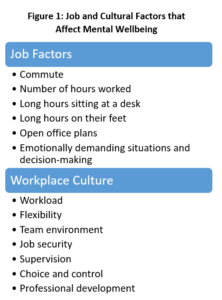A quick search for workplace wellness programs reveals that there are dozens of ways to manage mental health at work. For instance, employers can post motivational signs, start weekly yoga classes, or implement mindfulness programs for their employees. They can also train their management on being sensitive to mental health issues. With so many options available, how can employers make informed decisions about supporting mental wellbeing in the workplace, while also ensuring that their investments are cost-effective?
 Success in managing mental health at work is multifaceted. First, many mental health challenges arise out of workplace policies and behaviors. Therefore understanding these underlying drivers is key to prevention and mitigation. Second, wellness programs are not one-size-fits-all. Their success depends on whether or not they meet the needs of the employees.
Success in managing mental health at work is multifaceted. First, many mental health challenges arise out of workplace policies and behaviors. Therefore understanding these underlying drivers is key to prevention and mitigation. Second, wellness programs are not one-size-fits-all. Their success depends on whether or not they meet the needs of the employees.
Sapien Labs’ Mental Health Quotient (MHQ) is a comprehensive tool that provides mental health insights to individuals and organizations. Based on a thorough analysis of 126 different mental health assessment tools, the MHQ can show employers the problems that may influence poor mental health and the strengths that the organization can build upon for all of their employees. The MHQ is an anonymous, online tool that takes 15 minutes or less to complete. Employers receive an overall picture of their employees’ mental wellbeing without compromising employee privacy.
What Can Employers Learn from the MHQ?
The MHQ provides employers with three valuable pieces of information:
- A current snapshot of employee mental health and wellbeing
- The workplace factors that are influencing employees’ mental health status
- A way to evaluate wellness programs over time
Mental Health Snapshot
The MHQ can give employers an overall understanding of mental health and wellbeing in their workplace. The MHQ can also show how well employees are functioning under six different dimensions of wellbeing.
Table 1: MHQ Dimensions of Mental Well-Being
| Dimension | Description | Brain Functions |
| Core Cognition | The ability to function independently and effectively | Attention, memory, learning, self-control |
| Complex Cognition | The ability to synthesize and understand complex information and events. Also, the ability to engage in long-term thinking and planning | Decision-making, creativity, problem-solving, planning, adaptability |
| Mood and Outlook | The ability to manage emotions effectively | Self-regulation skills, especially when faced with fear, anger, anxiety, guilt, or sadness |
| Drive and Motivation | The ability to set and achieve goals. | Interest, curiosity, motivation, and energy levels |
| Social Self | The ability to interact with, relate to, and see oneself in other people | Confidence, communication skills, self-worth, empathy |
| Mind-Body | The ability to balance the mind and body to ensure that mental health challenges do not manifest into physical symptoms | Sleep, appetite, coordination, fatigue |
Having a snapshot of employees’ mental wellbeing can be especially helpful during times of rapid change. For instance, experts have expressed concern about the long-term mental health effects of the coronavirus pandemic. As employees return to work after COVID-19, the MHQ can show employers the types of difficulties their employees are encountering during this global traumatic event.
Workplace Factors Influencing Mental Health (fig.1)
The MHQ provides employers with a comprehensive list of workplace factors that are impacting mental wellbeing. These factors fall under two categories: job factors and workplace culture. This data can be broken down by office location, department, and demographics. With this information, employers can see what types of factors are impacting different groups of employees.
As an example, say that MHQ results show that for Company A, employees in the Customer Service Department have poorer mental health than any other department at any location. This department scores particularly low for the Mind-Body dimension of the MHQ. Employees frequently complain about aches and pains, and long hours at the computer appear to be a factor.
To address the issues, Company A develops a specific plan to support the Customer Service Department. The company decides to purchase ergonomic furniture to ease aches and pains. The company also implements a policy that mandates breaks throughout the day.
Program Evaluation
Finally, the MHQ provides companies with baseline mental health data that it can use to evaluate wellness initiatives over time. For instance, Company A may ask the Customer Service Department to retake the MHQ six months after implementing the break policy to see if mental wellbeing has improved. The Centers for Disease Control (CDC) strongly recommend evaluating workplace wellness programs to assess their quality, cost-effectiveness, and overall impact on employees.
Get Started
The MHQ is a thorough assessment tool that companies can use over and over again to assess needs, inform strategy, and measure success. Companies are already showing interest in the MHQ to help with managing mental health at work. For more information about how the MHQ can help your business, please contact us using this form or email us at info@sapienlabs.org.


















